RSAF combines sensors, shooters and AI in 'state-of-the-art' system to better defend Singapore's airspace
SINGAPORE — The term "artificial intelligence (AI)" can be mystifying, but on the screen before us, the picture is straightforward: A yellow diamond represents Singapore and multiple green specks — Singapore's air defence assets — are contained within.
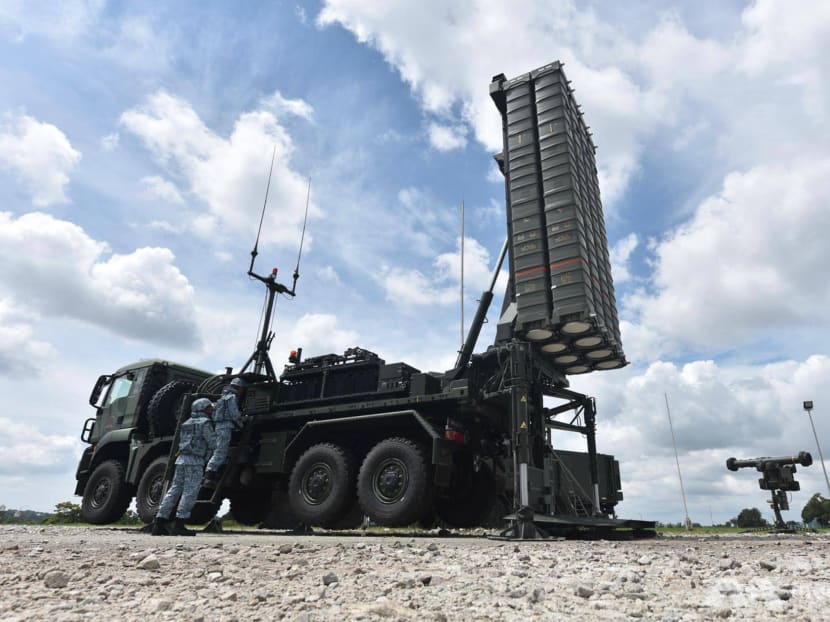
Republic of Singapore Air Force operators prepare the Aster 30, a remotely controlled anti-aircraft missile launcher with a range of 70km. It is seen beside an RBS 70 system, a portable air defence missile system with a range of up to 8km.
SINGAPORE — The term "artificial intelligence (AI)" can be mystifying, but on the screen before us, the picture is straightforward: A yellow diamond represents Singapore and multiple green specks — Singapore's air defence assets — are contained within.
A yellow icon appears outside the diamond and suddenly turns red. It is moving towards Singapore and the system has identified it as an enemy fighter jet.
Republic of Singapore Air Force (RSAF) commanders select the red target and a small square automatically appears beside it, recommending that the fighter jet is best countered with the Aster 30, a remotely controlled anti-aircraft missile launcher with a range of 70km.
When commanders give the go-ahead to use that weapon, a blue line shoots out of one of the green icons, predicting the missile trajectory. This ensures no friendly planes are in the line of fire.
After commanders launch the missile, the blue line gets shorter and shorter, until the target disappears.
The enemy has been neutralised.
What reporters witnessed on Thursday (Dec 17) was an example of how the combat management system in RSAF's Island Air Defence (IAD) system uses artificial intelligence to enable commanders to make quicker and more effective decisions when defending Singapore's airspace.
The demonstration was held at Lim Chu Kang Camp 2.
The IAD system also combines this software with RSAF’s sensors and shooters — a range of radars, anti-air missiles and fighter aircraft — to allow the RSAF to see more and make better sense of all that information on a single picture.
Previously, individual weapon platforms would use their own sensors, limiting what they could see. With the IAD system, the platforms and radars can “talk” with each other, offering commanders a more complete yet easy to understand situational picture.
The Ministry of Defence (Mindef) said in a news release on Thursday that the IAD system also reduces the cognitive load on operators and prevents a single point of failure.
This means that if one weapon platform is taken out, the system can automatically recommend another platform to take over.

“We don’t rely on individual capabilities (but instead) on the strength of multiple systems,” said Colonel Loh Woon Liang, commander of the Air Defence Group.
“It allows us to enhance the robustness of the networked system rather than to look at multiple points in a single defence system. And for a country like Singapore, it’s really important to be able to do that.”
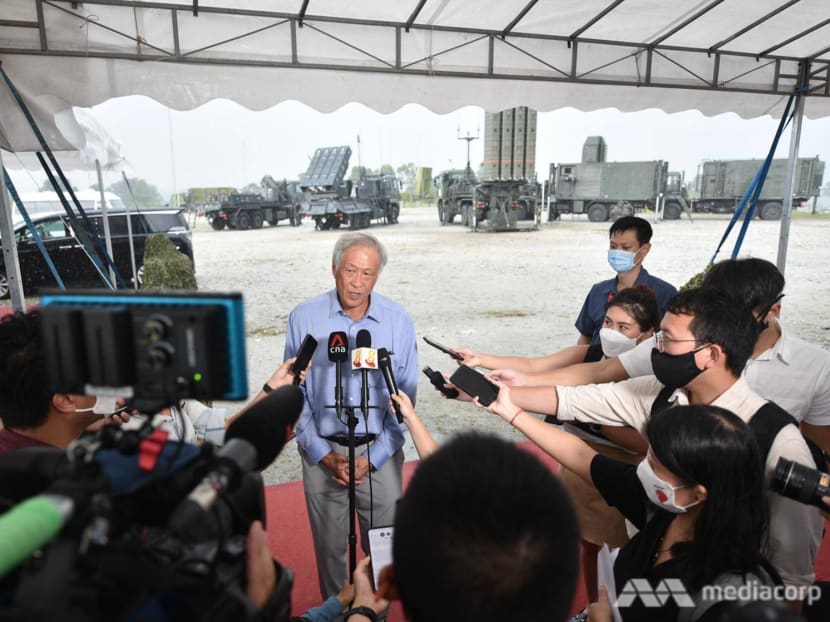
Defence Minister Ng Eng Hen reiterated on Thursday that Singapore’s small size and highly dense population means it will “always be vulnerable” to threats from the air.
In 2016, six Indonesian militants plotted to fire a rocket at Marina Bay from Batam. In 2002, radicalised individuals planned to hijack a plane and crash it into Changi Airport.
“Those threats are evolving, whether they are longer-range munitions... or non-traditional, from terrorist attacks — things you can buy on the dark web,” said Dr Ng after being briefed on the latest version of the IAD system, which in August integrated the Aster 30.
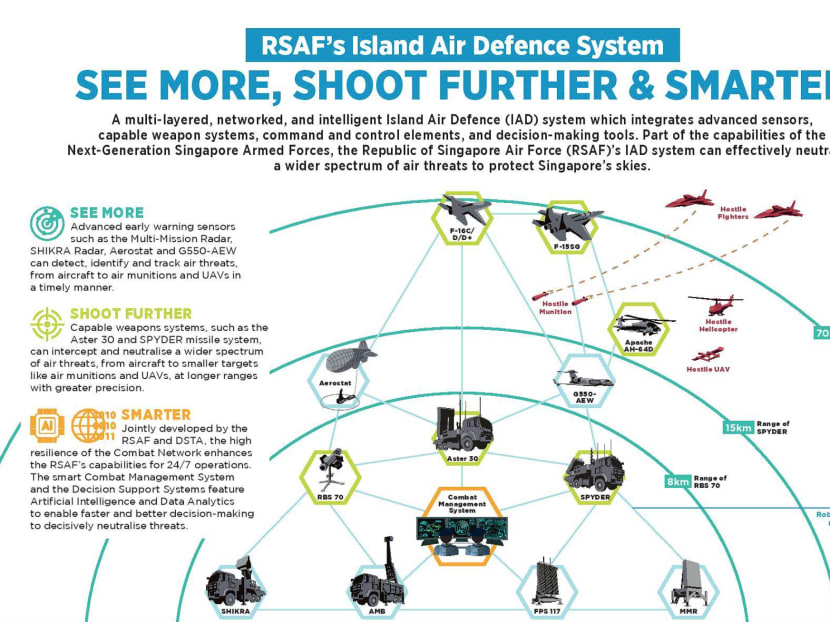
The IAD system, conceptualised in 2006, comprises a number of ground-based and airborne radars to detect targets at various ranges and altitudes, as well as different weapon platforms to take down missiles, drones and fighter aircraft.
The system has been integrated with newer platforms and improved over the years, with Dr Ng saying it will serve Singapore “for the next few decades”.
“Our current systems are state-of-the-art, at least against munitions that are on the market at subsonic or supersonic (capabilities),” he added.
“If you’re talking about hypersonic missiles, then very few militaries have capabilities to respond to (that). But that’s maybe 20 or 30 years down the line.”
SHOOTERS
For instance, the Aster 30 missile system is capable of engaging multiple threats simultaneously, including fighter aircraft, helicopters, drones and precision-guided missiles.

The Surface-to-Air Python-5 and Derby-Air Defence System (Spyder) is another system with anti-aircraft and anti-munition capabilities. Its infrared and laser-guided missiles have an effective interception range of 15km.
The RBS 70 system is a portable air defence missile system with a range of up to 8km. It can be deployed in both mounted and dismounted configurations for more operational flexibility, Mindef said.
SENSORS
When it comes to sensors, the RSAF uses the Multi-Mission Radar with an effective detection range of up to 350km and 100km for air surveillance and hostile weapon locating respectively.
The FPS 117 radar is another high-precision air defence radar with an effective detection range of up to 463km.
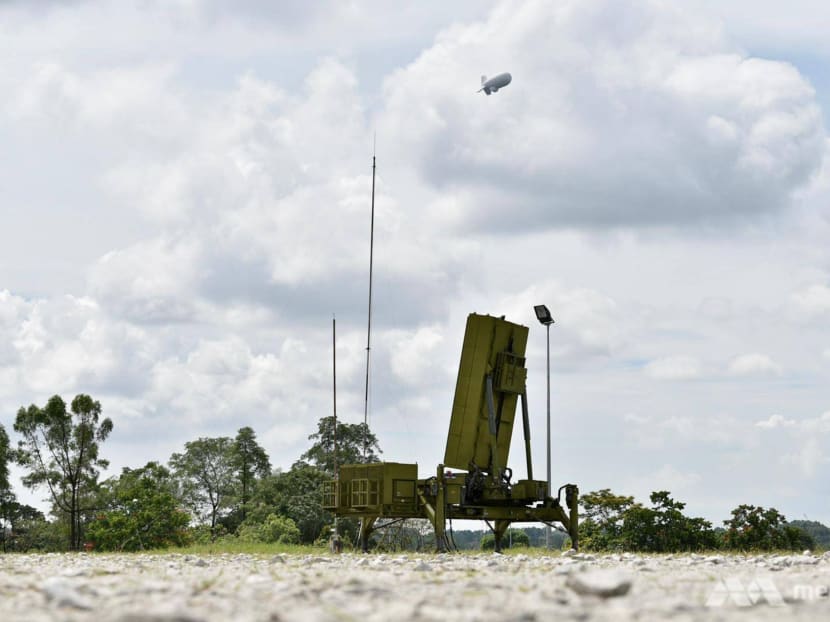
For low-level surveillance, the RSAF also has the System for Hybrid Interceptor Knowledge of Recognised Air (Shikra) mobile radar and Agile Multiple Beam (AMB) radar, with a range of up to 100km and 60km respectively.
The latter detects low-flying and slower-moving targets like helicopters, Mindef said.
Given Singapore’s low-lying geographical features, the RSAF also operates airborne radars like the Aerostat and Gulfstream 550 — Airborne Early Warning (G550-AEW).

The Aerostat is a tethered balloon system that operates at 600m in the sky to get a clear line of sight over Singapore’s airspace and seaspace. It has an effective detection range of up to 200km.
The G550-AEW has an advanced Active Electronically Scanned Array radar with an effective detection range of more than 370km. It provides persistent, all-weather ability to detect, identify and track aerial threats, Mindef said.
COMBAT MANAGEMENT SYSTEM
The combat management system, considered the brain of the operation, was developed with the Defence Science and Technology Agency (DSTA), which has tested and validated its safety and operational capabilities.
In one simulation, the system handled as many as 16 targets, suggesting which should be dealt with first depending on how quickly it could cross into Singapore airspace.
“It is especially important in today’s context when the threats come at you in a mess and you need decision support systems,” Col Loh said.
“It allows you to classify and prioritise which is the most dangerous threat you want to deal with, and (then) to deal with all of them.”

DSTA engineer and senior programme manager Teng Siang Loong said the concept of a networked system, with the combat management system in the middle of it, makes it more resilient.
“In the previous standalone system, if any equipment becomes unavailable, that particular system will not be able to perform its mission effectively,” he said.
“With the combat network, we are able to allow multiple weapons and sensors to operate in an optimised pool of resources.
“In the event that one of the equipment becomes unavailable, the next one will be able to undertake the responsibility.”

Third Warrant Officer Thiyagaraj Subramaniam, 30, an air defence systems specialist who operates the Aster 30, said the IAD system allows him to get the best out of his platform.
“It gives confidence to the ground operators that having all these systems and integrated assets means the mission which I’m a part of will definitely succeed,” he said.
CONSTANT DEVELOPMENT
But the RSAF is not resting on its laurels.
To defend against constantly evolving military technology like drone swarms, Col Loh said the RSAF and DSTA consistently look at the emerging threats and capabilities out there.
“We continue to renew our capabilities and make enhancements to deal with them,” he said.
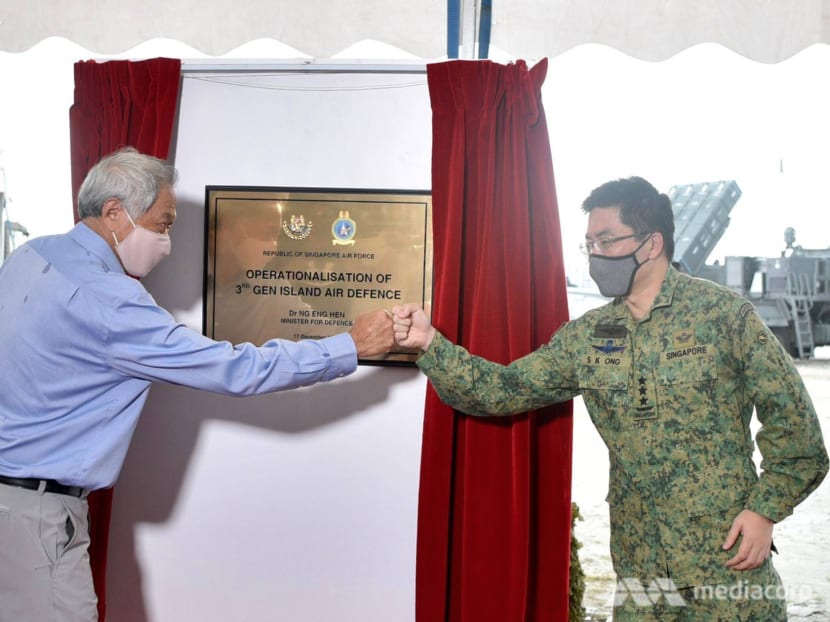
Dr Ng said the current IAD system is “compatible” with Singapore’s needs and threat assessment, as he called it a “significant improvement” over the years.
“I think Singaporeans can take comfort that we have this system up,” he added.
“It required continuous effort, integration over 15 years, and even as we have finished this phase, we’ll look towards the next phase of the IAD system (amid) threats that are not only on the horizon, but I’m sure will be developed over the years." CNA
For more stories like this, visit cna.asia









